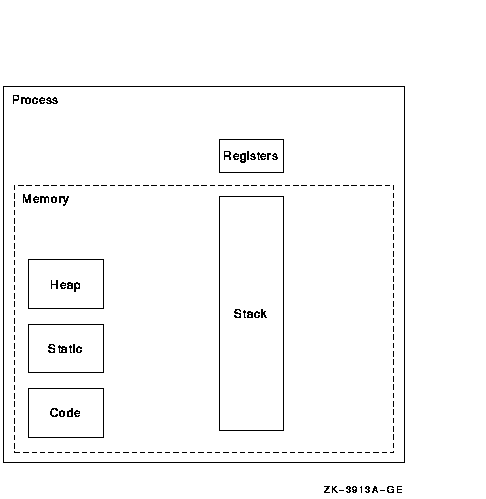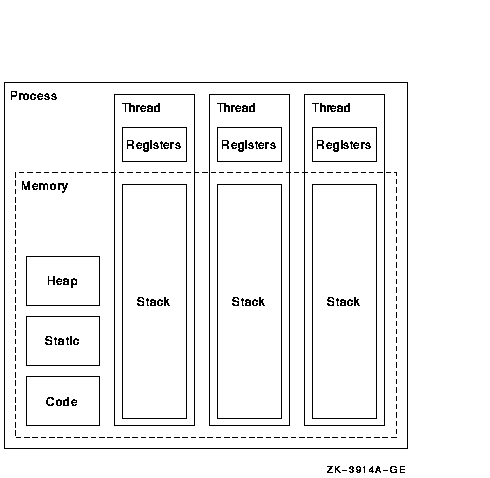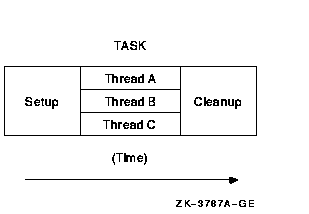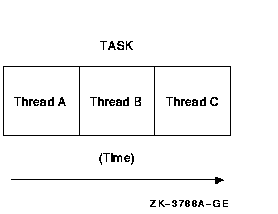![[Compaq]](../../images/compaq.gif)
![[Go to the documentation home page]](../../images/buttons/bn_site_home.gif)
![[How to order documentation]](../../images/buttons/bn_order_docs.gif)
![[Help on this site]](../../images/buttons/bn_site_help.gif)
![[How to contact us]](../../images/buttons/bn_comments.gif)
![[OpenVMS documentation]](../../images/ovmsdoc_sec_head.gif)
| Document revision date: 30 March 2001 | |
![[Compaq]](../../images/compaq.gif) |
![[Go to the documentation home page]](../../images/buttons/bn_site_home.gif)
![[How to order documentation]](../../images/buttons/bn_order_docs.gif)
![[Help on this site]](../../images/buttons/bn_site_help.gif)
![[How to contact us]](../../images/buttons/bn_comments.gif)
|
![[OpenVMS documentation]](../../images/ovmsdoc_sec_head.gif)
|
|
Order Number: AA--QSBPD--TE
This guide reviews the principles of multithreaded programming, as reflected in the IEEE POSIX 1003.1-1996 standard, and provides implementation guidelines and reference information for the Compaq Multithreading Run-Time Library.
Revision/Update Information: This manual supersedes the Guide to DECthreads, January 1999.
Software Version: OpenVMS Alpha Version 7.3 OpenVMS VAX Version 7.3
Compaq Computer Corporation Houston, Texas
© 2001 Compaq Computer Corporation
Compaq, VAX, VMS, and the Compaq logo Registered in the U.S. Patent and Trademark Office.
Tru64 and OpenVMS are trademarks of Compaq Information Technologies Group, L.P. in the United States and other countries.
Microsoft is a trademark of Microsoft Corporation in the United States and other countries. UNIX is a registered trademark and The Open Group is a trademark of The Open Group in the U.S. and other countries.
All other product names mentioned herein may be trademarks of their respective companies.
Confidential computer software. Valid license from Compaq required for possession, use, or copying. Consistent with FAR 12.211 and 12.212, Commercial Computer Software, Computer Software Documentation, and Technical Data for Commercial Items are licensed to the U.S. Government under vendor's standard commercial license.
The information in this document is provided "as is" without warranty of any kind and is subject to change without notice. The warranties for Compaq products are set forth in the express limited warranty statements accompanying such products. Nothing herein should be construed as constituting an additional warranty.
ZK6493
The Compaq OpenVMS documentation set is available on CD-ROM.
| Contents | Index |
This guide describes the POSIX Threads Library, Compaq's Multithreading Run-Time Library. In addition to introducing components for building multithreaded applications and libraries to be called from either single-threaded or multithreaded programs, this guide reviews the key principles of multithreaded programming.
This guide also presents the concepts behind thread-safe and multithreaded processing environments and provides guidelines for using the library to implement them on various Compaq platforms. Finally, this guide describes in detail each routine in the two recommended Compaq interfaces:
The interface you select depends upon your goals and the anticipated environment for your software.
As a complement to this guide, and for a user's guide to multithreaded programming using the pthreads standard, we recommend the following:
Programming with POSIX Threads by David R. Butenhof, published as part of the Addison-Wesley Professional Computing Series (ISBN 0-201-63392-2).
The Single UNIX Specification, Version 2, The Open Group (ISBN 85912-181-0). Available online at http://www.opengroup.org/onlinepubs/7908799/toc.htm.
This guide is for system and application programmers who use the POSIX Threads Library either to create multithreaded applications or to create thread-safe code libraries that can be called from either single-threaded or multithreaded applications.
This guide consists of the following:
See your system's documentation set for more information on that system. This manual covers the version of the POSIX Threads Library available on the following platforms:
For a complete list and description of the books in the OpenVMS documentation set, see the OpenVMS Version 7.3 New Features and Documentation Overview.
Some books in the OpenVMS or Tru64 UNIX documentation set help meet the needs of several audiences. For example, the information in some system manager, system administrator, or user books is also used by programmers. Keep this in mind when searching for information on specific topics. The New Features Manual provides information on all of the books in the OpenVMS or Tru64 UNIX documentation set.
For additional information on the Open Systems Software Group (OSSG) products and services, access the Compaq World Wide Web site at the following location:
http://www.openvms.compaq.com/ |
Compaq welcomes your comments on this guide. Please send comments to any of the following addresses:
| Fax | 603 881-0120, Attention: Core Technology Group, ZKO2-3/Q18 |
|
Compaq Computer Corporation
Core Technology Group, ZKO2-3/Q18 110 Spit Brook Rd. Nashua, NH 03062-2698 |
VMScluster systems are now referred to as OpenVMS Cluster systems. Unless otherwise specified, references to OpenVMS Clusters or clusters in this document are synonymous with VMSclusters.
In this manual, every use of DECwindows and DECwindows Motif refers to DECwindows Motif for OpenVMS software.
The following conventions are used in this manual:
| Ctrl/ x | A sequence such as Ctrl/ x indicates that you must hold down the key labeled Ctrl while you press another key or a pointing device button. |
| PF1 x | A sequence such as PF1 x indicates that you must first press and release the key labeled PF1 and then press and release another key or a pointing device button. |
| [Return] |
In examples, a key name enclosed in a box indicates that you press a
key on the keyboard. (In text, a key name is not enclosed in a box.)
In the HTML version of this document, this convention appears as brackets, rather than a box. |
| ... |
A horizontal ellipsis in examples indicates one of the following
possibilities:
|
|
.
. . |
A vertical ellipsis indicates the omission of items from a code example or command format; the items are omitted because they are not important to the topic being discussed. |
| ( ) | In command format descriptions, parentheses indicate that you must enclose choices in parentheses if you specify more than one. |
| [ ] | In command format descriptions, brackets indicate optional choices. You can choose one or more items or no items. Do not type the brackets on the command line. However, you must include the brackets in the syntax for OpenVMS directory specifications and for a substring specification in an assignment statement. |
| | | In command format descriptions, vertical bars separate choices within brackets or braces. Within brackets, the choices are optional; within braces, at least one choice is required. Do not type the vertical bars on the command line. |
| { } | In command format descriptions, braces indicate required choices; you must choose one of the items listed. Do not type the braces on the command line. |
| bold text |
This typeface represents the introduction of a new term. It also
represents the name of an argument, an attribute, or a reason.
In the HTML version of this document, this convention appears as italic text. |
| italic text | Italic text indicates important information, complete titles of manuals, or variables. Variables include information that varies in system output (Internal error number), in command lines (/PRODUCER= name), and in command parameters in text (where dd represents the predefined code for the device type). |
| UPPERCASE TEXT | Uppercase text indicates a command, the name of a routine, the name of a file, or the abbreviation for a system privilege. |
| Monospace text |
Monospace type indicates code examples and interactive screen displays.
In the C programming language, monospace type in text identifies the following elements: keywords, the names of independently compiled external functions and files, syntax summaries, and references to variables or identifiers introduced in an example. |
| - | A hyphen at the end of a command format description, command line, or code line indicates that the command or statement continues on the following line. |
| numbers | All numbers in text are assumed to be decimal unless otherwise noted. Nondecimal radixes---binary, octal, or hexadecimal---are explicitly indicated. |
This chapter introduces the concepts of threads and multithreaded programming. It describes four functional models that can be a basis for constructing multithreaded applications. The concepts and techniques introduced here are described in more detail in Chapter 2 and in this guide's platform-specific appendixes.
This chapter's last section introduces the components of the POSIX
Threads Library package, in particular the pthread and
tis interfaces, and how those components support
building multithreaded applications and thread-safe libraries.
1.1 Advantages of Using Threads
Multithreaded programming means organizing and coding a program so that instances of its routines, called threads, can execute concurrently in the same process. You use threads to improve a program's performance---that is, its throughput, computational speed, responsiveness, or some combination.
Using threads can improve a program's performance on uniprocessor systems by permitting the overlap of input, output, or other slow operations with computational operations. Threads are useful in driving slow devices such as disks, networks, terminals, and printers. A multithreaded program can perform other useful work while waiting for the device to produce its next event, such as the completion of a disk transfer or the receipt of a packet from the network.
Using threads can also be advantageous when constructing an application's user interface. Consider the typical arrangement of a window system. Each time the user invokes an action (for example, by clicking on a mouse button), the program can use a separate thread to implement the action. If the user invokes multiple actions, multiple threads can perform the actions in parallel.
Using threads is especially advantageous when building a distributed system. These systems frequently contain a shared network server, where the server services requests from multiple clients. Using multiple threads allows the server to handle clients' requests in parallel, instead of artificially serializing them or creating (at great expense) one server process per client.
A program with multiple threads can be especially suited to run on a
multiprocessor system, where threads run concurrently on separate
processors. Threads created using the POSIX Threads Library are capable
of utilizing multiprocessors, if the target platform supports
parallelism within a process. Compaq's Tru64 UNIX platforms and OpenVMS
Alpha platforms support parallelism; the OpenVMS VAX platform does not
support parallelism.
1.2 Overview of Threads
A thread is a single, sequential flow of control within a process. Within each thread there is a single point of execution. Most traditional programs execute as a process with a single thread. Figure 1-1 and Figure 1-2 show the differences between a single-threaded process and a multithreaded process.
Figure 1-1 Single-Threaded Process

In Figure 1-2, notice that multiple threads share heap storage, static storage, and code but that each thread has its own register set and stack.
Using Compaq's multithreading run-time library, a programmer can create several threads within a process. The process' threads execute concurrently. Within a multithreaded program there are at any time multiple points of execution.
Threads execute within (and share) a single address space; therefore, a process' threads can read and write the same memory locations. When the threads access the same memory locations, your program must use synchronization elements, such as mutexes and condition variables, to ensure that the shared memory is accessed correctly. The Threads Library provides routines that allow you to use these and other synchronization objects. Section 2.4 describes the synchronization objects that the Threads Library offers as well as the operations your program can perform on them.
Figure 1-2 Multithreaded Process

You should design and code a multithreaded program with the assumption that its threads execute simultaneously. That is, your program cannot make assumptions about the relative start or finish times of its threads or the sequence in which they execute. These are governed by the thread scheduler, part of the run-time environment that the Threads Library establishes before your program begins running. Nevertheless, your program can influence how threads are scheduled by setting each thread's scheduling policy and scheduling priority. ( Section 2.3.6 describes how thread scheduling works.)
Each thread has its own thread identifier, which distinguishes it from all other threads in the process. In addition to the thread's scheduling policy and scheduling priority, each thread is associated with any thread-specific instances of data objects and with thread-specific system resources to support a flow of control.
A thread changes its state over the course of its execution. A thread is in one of the following states:
Figure 1-3 shows the transitions between states for a typical thread implementation.
Figure 1-3 Thread State Transitions

The following sections describe four functional models of processing information that are especially well suited for implementation in multithreaded programs:
In a boss/worker model, one thread functions as the "boss" because it assigns tasks for "worker" threads to perform. Each worker performs a distinct task until it has finished, at which point it notifies the boss that it is ready to receive another task. Alternatively, the boss polls workers periodically to see whether any is ready to receive another task.
A variation of the boss/worker model is the work queue model. The boss places tasks in a queue, and workers check the queue and take tasks to perform. When there are multiple bosses, this is often called producer/consumer.
An example of the work queue model in an office environment is a
secretarial typing pool. The office manager boss puts documents to be
typed in a basket, and worker typists take documents from the basket to
work on.
1.4.2 Work Crew Model
In the work crew model, multiple threads work together on a single task. The task is divided into pieces that are performed in parallel, and each thread performs one piece.
An example of a work crew is a group of people cleaning a building. Each person cleans certain rooms or performs certain types of work (washing floors, polishing furniture, and so forth), and each works independently.
In a multithreaded program that reflects the work crew model, each thread executes a task that can be performed in parallel. Figure 1-4 shows a task performed by three threads in a work crew model.
Figure 1-4 Work Crew Model of Thread Operation

In the pipelining model, a task is divided into steps. The steps must be performed in sequence to produce a single instance of the desired result, and the work done in each step (except for the first and last) is based on the previous step and is a prerequisite for the work in the next step. However, the goal is to produce multiple instances of the desired result, and the steps are designed to operate in parallel: while one step is performed on one instance of the result, the preceding step can be performed on the next instance of the result.
An example of the pipelining model is an automobile assembly line. Each step or stage in the assembly line is continually busy receiving the product of the previous stage's work, performing its assigned work, and passing the product along to the next stage.
In a multithreaded program that reflects the pipelining model, each thread executes a step in the task. Figure 1-5 shows a task performed by three threads in a pipelining model.
Figure 1-5 Pipelining Model of Thread Operation

If the task that your program performs is complex, you might find it appropriate to organize it as a combination of the functional models previously described. For example, a program could follow the pipelining model, but with one or more steps performed by a set of threads that follow a work crew model. In addition, threads could be assigned to a work crew by taking a task from a work queue and deciding (based on the task characteristics) which threads are needed for the work crew.
| Next | Contents | Index |
![[Go to the documentation home page]](../../images/buttons/bn_site_home.gif)
![[How to order documentation]](../../images/buttons/bn_order_docs.gif)
![[Help on this site]](../../images/buttons/bn_site_help.gif)
![[How to contact us]](../../images/buttons/bn_comments.gif)
|
| privacy and legal statement | ||
| 6101PRO.HTML | ||